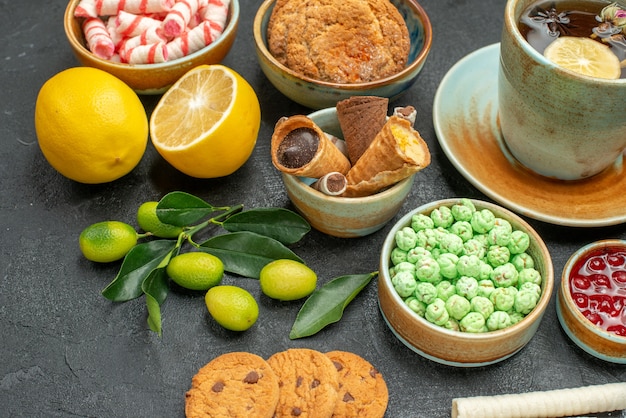
Overview
Itchy, scratchy skin. Unexplained sneezing and red, watery eyes. Constant headaches? Is this an allergy — or something else? You may be experiencing histamine intolerance — when too many of these compounds have built up in your blood, causing an allergy-like reaction. Histamines themselves are immune fighters that respond to foreign invaders, like pollen or food you’re sensitive to. But when you get too much, then pow! — histamine intolerance hits.
Histamine intolerance is not the same as histamine sensitivity. If you’re histamine-sensitive, any amount will cause a reaction. With intolerance, your body has accumulated too many, and you are dealing with a temporary overload. While the body naturally breaks down histamines, if you get too many at once, your body’s natural processes may not be able to keep up.
What Is A Histamine?
Most of us know about antihistamines. When you have seasonal allergies, for example, antihistamine medications relieve your symptoms like watery eyes, a runny nose, sneezing, and congestion. Antihistamines are designed to counteract histamines.
Your white blood cells (immune fighters) produce histamines in response to an allergic reaction or injury. Histamines help rid your body of something the body does not want, such as pollen or dust.
Histamines can make you sneeze or itch, but do so for a useful purpose: to protect the body. Histamines make your blood vessels dilate so that your white blood cells can race faster to the site of an infection or injury.
Sometimes your cells release too many histamines. This causes something similar to an allergic response. Some people experience unexplained headaches or migraines, while others have digestive issues, break out in hives or rashes, or feel nauseous or tired. Others get an itchy or swollen tongue when they eat foods, like bananas, avocados, or eggplants, or become flushed when they drink red wine. If you experience symptoms like these, histamine intolerance could be the culprit.
Histamine Intolerance vs. Histamine Reaction
A histamine reaction is part of the body’s natural immune response mechanism.
Histamine intolerance occurs when that natural reaction goes overboard, your body can’t break enough down, and a stronger reaction occurs.
Intolerance is a disequilibrium in the body between having too many histamines and not being able to break them down fast enough.
How Common is Histamine Intolerance?
Histamine intolerance affects at least one percent of the population, though the actual percentage of people affected is thought to be higher. Eighty percent of people affected are middle-aged or older — although it’s not clear why.
Many people don’t realize they have histamine intolerance because they don’t make a mental connection between their symptoms and the condition — if you’ve even heard of it.
What Causes High Histamine Levels?
Your body produces the enzyme diamine oxidase (DAO) that breaks down histamines. When there’s not enough DAO to regulate the amount of histamine in the body, you can end up with high levels.
Beyond that, several other factors can lead to elevated levels of histamine, including:
Medications with side effects that block DAO
Allergies
Bacterial overgrowth (SIBO)
A gastrointestinal disorder such as leaky gut syndrome or inflammatory bowel disease
Histamine-rich foods
Foods that impair DAO’s function, block the enzyme, or trigger the release of histamines
Stress
Remedies for Histamine Intolerances
If you know that you have histamine intolerance, you can take action to relieve your symptoms. The following strategies can form the cornerstone of your histamine intolerance plan.
Follow a Low-Histamine Diet
If you experience histamine intolerance on a regular basis, you may want to modify your diet. That means avoiding intake of histamine-rich food, foods that trigger histamine release in the body, and foods that block DAO production.
A truly histamine-free diet does not exist, but focusing on the right foods can help improve your symptoms.
Interestingly, exercise can increase histamine production in the short term. Done in moderation and combined with a low-histamine diet, exercise can help relieve histamine intolerance in the long run. Aim to reduce stress, as well, which can affect histamine release and breakdown.
Load Up on Quercetin
The antioxidant plant compound quercetin — found in such foods as onions, broccoli, apples, berries, and grapes — may help to relieve the symptoms of histamine intolerance. Quercetin stimulates the immune system and inhibits histamine release. You can get quercetin from your diet, or you can try a high-quality, organic quercetin supplement. Just make sure if you do look for quercetin in your diet, you avoid any high-histamine quercetin-rich foods, like strawberries or wine.
Bump Up Your Vitamin C
Vitamin C is a natural antihistamine. One to three grams of the vitamin can reduce histamine levels in the blood. Experts believe vitamin C helps DAO enzymes do their work of breaking down histamines.
The DAO enzyme relies on several nutrients to do its job, including copper, vitamin B-6, zinc, and magnesium, in addition to vitamin C.
Get Enough Magnesium
Magnesium is also necessary for DAO to do its work. If you are deficient in magnesium, taking a supplement or eating a magnesium-rich diet may help drop your histamine levels.
Although many types of magnesium exist, magnesium orotate is most readily absorbed by your cells. Orotates allow the mineral to cross through your cell membranes, making it available quickly.
Try Stinging Nettles
Stinging nettles are another excellent choice if you suffer from histamine intolerance. Nettle extract (Urtica dioica) can help to block the body’s histamine receptors.
Freeze-dried nettles may be particularly helpful in relieving histamine symptoms.
Take the Right Probiotics
Gut health is essential in dealing with histamine intolerance. The bacteria in your gut play an important role in both the production and degradation of histamine.
If you have histamine intolerance, take a probiotic that breaks down this compound. These include Lactobacillus plantarum, Lactobacillus rhamnosus, and Bifidobacterium lactis.
Top 10 Low Histamine Foods
Certain foods are lower in histamine than others. These are the best dietary choices for people experiencing histamine intolerance. Include these foods on the “yes” list for your histamine intolerance diet:
Gluten-free grains such as rice, quinoa, millet, and oats
Dairy substitutes such as almond milk and rice milk
Fresh fruit (see exceptions below)
Fresh vegetables (see exceptions below)
Most healthy cooking oils including olive oil and coconut oil
Leafy herbs
Herbal teas (see exceptions below)
Foods to Avoid
There are three types of food that you will want to avoid if you think you are experiencing histamine intolerance. These include histamine-rich foods, histamine-releasing foods, and DAO-blocking foods. Avoid these foods until you can identify your specific triggers. Not everyone with histamine tolerance must avoid them permanently, take some time to identify which foods or food types cause a reaction for you.
Histamine-Rich Foods to Avoid
Histamine-rich foods naturally contain a significant amount of histamine.
Fermented alcohol including wine, beer, and champagne
Fermented foods, including yogurt, sauerkraut, vinegar, soy sauce, miso
Foods containing vinegar including pickles, olives, mayonnaise
Cured, smoked, or processed meat and fish, such as bacon, hot dogs, salami, and pepperoni
Shellfish
Soured foods including buttermilk, sour cream, and sourdough bread
Aged cheeses
Dried fruits
Yeast
Soy sauce, Worcestershire sauce
Tomatoes, spinach, avocados, and eggplant
Histamine-Releasing Foods
Histamine-releasing foods may only contain a little histamine, yet they cause your body’s mast cells to release the compound.
Citrus fruits (lemon, oranges, lime, grapefruit)
Bananas, strawberries, papayas, pineapple
Tomatoes
Cow’s milk
Chocolate
Nuts
Shellfish
Wheat germ
Artificial preservatives and dyes



